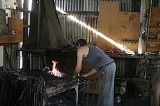
Forge
Encyclopedia
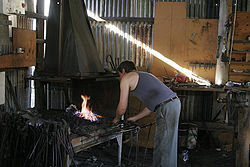

Hearth
In common historic and modern usage, a hearth is a brick- or stone-lined fireplace or oven often used for cooking and/or heating. For centuries, the hearth was considered an integral part of a home, often its central or most important feature...
used for forging
Forging
Forging is a manufacturing process involving the shaping of metal using localized compressive forces. Forging is often classified according to the temperature at which it is performed: '"cold," "warm," or "hot" forging. Forged parts can range in weight from less than a kilogram to 580 metric tons...
. The term "forge" can also refer to the workplace of a smith
Smith (metalwork)
A metalsmith, often shortened to smith, is a person involved in making metal objects. In contemporary use a metalsmith is a person who uses metal as a material, uses traditional metalsmithing techniques , whose work thematically relates to the practice or history of the practice, or who engages in...
or a blacksmith
Blacksmith
A blacksmith is a person who creates objects from wrought iron or steel by forging the metal; that is, by using tools to hammer, bend, and cut...
, although the term smithy is then more commonly used.
The basic smithy contains a forge, also known as a hearth, for heating metals. The forge heats the workpiece to a malleable temperature (a temperature where the metal becomes easier to shape) or to the point where work hardening
Work hardening
Work hardening, also known as strain hardening or cold working, is the strengthening of a metal by plastic deformation. This strengthening occurs because of dislocation movements within the crystal structure of the material. Any material with a reasonably high melting point such as metals and...
no longer occurs. The workpiece is transported to and from the forge using tongs
Tongs
Tongs are used for gripping and lifting tools, of which there are many forms adapted to their specific use. Some are merely large pincers or nippers, but the greatest number fall into three classes:...
. The tongs are also used to hold the workpiece on the smithy's anvil
Anvil
An anvil is a basic tool, a block with a hard surface on which another object is struck. The inertia of the anvil allows the energy of the striking tool to be transferred to the work piece. In most cases the anvil is used as a forging tool...
while the smith works it with a hammer
Hammer
A hammer is a tool meant to deliver an impact to an object. The most common uses are for driving nails, fitting parts, forging metal and breaking up objects. Hammers are often designed for a specific purpose, and vary widely in their shape and structure. The usual features are a handle and a head,...
. Finally the workpiece is transported to the slack tub, which rapidly cools the workpiece in a large body of water. The slack tub also provides water to control the fire in the forge.
Coal/coke/charcoal forge
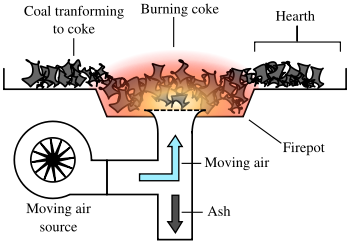
Coal
Coal is a combustible black or brownish-black sedimentary rock usually occurring in rock strata in layers or veins called coal beds or coal seams. The harder forms, such as anthracite coal, can be regarded as metamorphic rock because of later exposure to elevated temperature and pressure...
, industrial coke
Coke (fuel)
Coke is the solid carbonaceous material derived from destructive distillation of low-ash, low-sulfur bituminous coal. Cokes from coal are grey, hard, and porous. While coke can be formed naturally, the commonly used form is man-made.- History :...
or charcoal
Charcoal
Charcoal is the dark grey residue consisting of carbon, and any remaining ash, obtained by removing water and other volatile constituents from animal and vegetation substances. Charcoal is usually produced by slow pyrolysis, the heating of wood or other substances in the absence of oxygen...
as the fuel to heat metal. The designs of these forges have varied over time, but whether the fuel is coal, coke or charcoal the basic design has remained the same.
A forge of this type is essentially a hearth or fireplace
Fireplace
A fireplace is an architectural structure to contain a fire for heating and, especially historically, for cooking. A fire is contained in a firebox or firepit; a chimney or other flue allows gas and particulate exhaust to escape...
designed to allow a fire to be controlled such that metal introduced to the fire may be brought to a malleable state or to bring about other metallurgical effects (hardening, annealing, and drawing temper as examples). The forge fire in this type of forge is controlled in three ways: amount of air, volume of fuel, and shape of the fuel/fire.
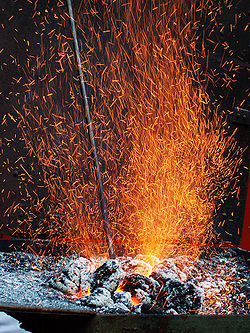
- Tuyere — a pipe through which air can be forced into the fire
- BellowsBellowsA bellows is a device for delivering pressurized air in a controlled quantity to a controlled location.Basically, a bellows is a deformable container which has an outlet nozzle. When the volume of the bellows is decreased, the air escapes through the outlet...
or blower — a means for forcing air into the tuyere - Firepot or hearth — a place where the burning fuel can be contained over or against the tuyere opening.
During operation, fuel is placed in or on the hearth and ignited. A source of moving air, such as a fan
Fan (mechanical)
A mechanical fan is a machine used to create flow within a fluid, typically a gas such as air.A fan consists of a rotating arrangement of vanes or blades which act on the air. Usually, it is contained within some form of housing or case. This may direct the airflow or increase safety by preventing...
or bellows, introduces additional air into the fire through the tuyere. With additional air, the fire consumes more fuel and burns hotter.

In a typical, but by no means universal, coal forge, a firepot will be centered in a flat hearth. The tuyere will enter the firepot at the bottom. In operation, the hot core of the fire will be a ball of burning coke in and above the firepot. The heart of the fire will be surrounded by a layer of hot but not burning coke. Around the unburnt coke will be a transitional layer of coal being transformed into coke by the heat of the fire. Surrounding all is a ring or horseshoe-shaped layer of raw coal, usually kept damp and tightly packed to maintain the shape of the fire's heart and to keep the coal from burning directly so that it "cooks" into coke first.
If a larger fire is necessary, the smith increases the air flowing into the fire as well as feeding and deepening the coke heart. The smith can also adjust the length and width of the fire in such a forge to accommodate different shapes of work.
The major variation from the forge and fire just described is a 'back draft' where there is no fire pot, and the tuyere enters the hearth horizontally from the back wall.
Coke and charcoal may be burned in the same forges that use coal, but since there is no need to convert the raw fuel at the heart of the fire (as with coal), the fire is handled differently.
Individual smiths and specialized applications have fostered development of a variety of forges of this type, from the coal forge described above, to simpler constructions amounting to a hole in the ground with a pipe leading into it.
Gas forge
A gas forge typically uses propanePropane
Propane is a three-carbon alkane with the molecular formula , normally a gas, but compressible to a transportable liquid. A by-product of natural gas processing and petroleum refining, it is commonly used as a fuel for engines, oxy-gas torches, barbecues, portable stoves, and residential central...
or natural gas
Natural gas
Natural gas is a naturally occurring gas mixture consisting primarily of methane, typically with 0–20% higher hydrocarbons . It is found associated with other hydrocarbon fuel, in coal beds, as methane clathrates, and is an important fuel source and a major feedstock for fertilizers.Most natural...
as the fuel. One common, efficient design uses a cylindrical forge chamber and a burner tube mounted at a right angle to the body. The chamber is typically lined with refractory
Refractory
A refractory material is one that retains its strength at high temperatures. ASTM C71 defines refractories as "non-metallic materials having those chemical and physical properties that make them applicable for structures, or as components of systems, that are exposed to environments above...
materials, preferably a hard castable refractory ceramic
Ceramic
A ceramic is an inorganic, nonmetallic solid prepared by the action of heat and subsequent cooling. Ceramic materials may have a crystalline or partly crystalline structure, or may be amorphous...
. The burner mixes fuel and air which are ignited at the tip, which protrudes a short way into the chamber lining. The air pressure, and therefore heat, can be increased with a mechanical blower or by taking advantage of the Venturi effect
Venturi effect
The Venturi effect is the reduction in fluid pressure that results when a fluid flows through a constricted section of pipe. The Venturi effect is named after Giovanni Battista Venturi , an Italian physicist.-Background:...
.
Gas forges vary in size and construction, from large forges using a big burner with a blower or several atmospheric burners to forges built out of a coffee
Coffee
Coffee is a brewed beverage with a dark,init brooo acidic flavor prepared from the roasted seeds of the coffee plant, colloquially called coffee beans. The beans are found in coffee cherries, which grow on trees cultivated in over 70 countries, primarily in equatorial Latin America, Southeast Asia,...
can utilizing a cheap, simple propane torch. A small forge can even be carved out of a single soft firebrick.
The primary advantage of a gas forge is ease of use, particularly for a novice. A gas forge is simple to operate compared to coal forges, and the fire produced is clean and consistent. They are less versatile, as the fire cannot be reshaped to accommodate large or unusually shaped pieces;. It is also difficult to heat a small section of a piece. A common misconception is that gas forges cannot produce enough heat to enable forge-welding
Welding
Welding is a fabrication or sculptural process that joins materials, usually metals or thermoplastics, by causing coalescence. This is often done by melting the workpieces and adding a filler material to form a pool of molten material that cools to become a strong joint, with pressure sometimes...
, but a well designed gas forge is hot enough for any task.
Finery forge
A finery forgeFinery forge
Iron tapped from the blast furnace is pig iron, and contains significant amounts of carbon and silicon. To produce malleable wrought iron, it needs to undergo a further process. In the early modern period, this was carried out in a finery forge....
is a water-powered mill where pig iron
Pig iron
Pig iron is the intermediate product of smelting iron ore with a high-carbon fuel such as coke, usually with limestone as a flux. Charcoal and anthracite have also been used as fuel...
is refined into wrought iron
Wrought iron
thumb|The [[Eiffel tower]] is constructed from [[puddle iron]], a form of wrought ironWrought iron is an iron alloy with a very low carbon...
.
Anvil
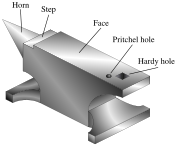
The anvil serves as a work bench to the blacksmith, where the metal to be forged is placed. Anvils are made of cast or wrought iron with a tool steel face welded on or of a single piece of cast or forged tool steel. The flat top has two holes; the square hole is called the hardy hole, where the square shank of the hardy fits. The smaller hole is called the punch hole, used as a bolster when punching holes in hot metal.
Chisel
ChiselChisel
A chisel is a tool with a characteristically shaped cutting edge of blade on its end, for carving or cutting a hard material such as wood, stone, or metal. The handle and blade of some types of chisel are made of metal or wood with a sharp edge in it.In use, the chisel is forced into the material...
s are made of high carbon steel. They are hardened and tempered at the cutting edge while the head is left soft so it will not crack when hammered. Chisels are of two types, hot and cold chisels. The cold chisel is used for cutting cold metals while the hot chisel is for hot metals. Usually hot chisels are thinner and therefore can not be substituted with cold chisels.
Tongs
Tongs are used by the blacksmith for holding hot metals securely. The mouths are custom made by the smith in various shapes to suit the gripping of various shapes of metalMetal
A metal , is an element, compound, or alloy that is a good conductor of both electricity and heat. Metals are usually malleable and shiny, that is they reflect most of incident light...
.
Fuller
Fullers are forming tools of different shapes used in making grooves or hollows. They are often used in pairs, the bottom fuller has a square shank which fits into the hardy hole in the anvil while the top fuller has a handle. The work is placed on the bottom fuller and the top is placed on the work and struck with a hammer. The top fuller is also used for finishing round corners and for stretching or spreading metal.Hardy
The hardy is a cutting tool similar to the chisel. It is used as a chisel or hammer for cutting both hot and cold metals. It has a square shank that fits into the hardy hole in the anvil, with the cutting edge facing upwards. The metal to be cut is placed on the cutting edge and struck with a hammer. They are also used with set tools which are placed over the workpiece and struck.Slack tub
A slack tub is usually a large container full of waterWater
Water is a chemical substance with the chemical formula H2O. A water molecule contains one oxygen and two hydrogen atoms connected by covalent bonds. Water is a liquid at ambient conditions, but it often co-exists on Earth with its solid state, ice, and gaseous state . Water also exists in a...
, brine
Brine
Brine is water, saturated or nearly saturated with salt .Brine is used to preserve vegetables, fruit, fish, and meat, in a process known as brining . Brine is also commonly used to age Halloumi and Feta cheeses, or for pickling foodstuffs, as a means of preserving them...
, or oil
Oil
An oil is any substance that is liquid at ambient temperatures and does not mix with water but may mix with other oils and organic solvents. This general definition includes vegetable oils, volatile essential oils, petrochemical oils, and synthetic oils....
used by a blacksmith to quench
Quench
In materials science, quenching is the rapid cooling of a workpiece to obtain certain material properties. It prevents low-temperature processes, such as phase transformations, from occurring by only providing a narrow window of time in which the reaction is both thermodynamically favorable and...
hot metal. The term is believed to derive from the word "slake", as in slaking the heat.
Drop Forging
Drop forging is a process used to shape metal into complex shapes by dropping a heavy hammer with a die on its face onto the work piece.Process
The workpiece is placed into the forge. Then the impact of a hammer causes the heated material, which is very malleable, to conform to the shape of the die and die cavities. Typically only one die is needed to completely form the part. The extra space between the die faces is called the flash. It acts as a relief valve for the extreme pressure produced by the closing of the die halves but is eventually trimmed off of the finished part.Equipment
The equipment used in the drop forming process is commonly known as a powerPower hammer
Power hammers are mechanical forging hammers that use a non-muscular power source to raise the hammer preparatory to striking, and accelerate it onto the work being hammered...
or drop hammer. These may be powered by air, hydraulics, or mechanics. Depending on how the machine is powered, the mass of the ram, and the drop height, the striking force can be anywhere from 11,000 to 425,000 pounds.
The tools that are used, dies and punches, come in many different shapes and sizes, as well as materials. Examples of these shapes are flat and v-shaped which are used for open-die forging, and single or multiple-impression dies used for closed die-forging. The designs for the dies have many aspects to them that must be considered. They all must be properly aligned, they must be designed so the metal and the flash will flow properly and fill all the grooves, and special considerations must be made for supporting webs and ribs and the parting line location. The materials must also be selected carefully. Some factors that go into the material selection are cost, their ability to harden, their ability to withstand high pressures, hot abrasion, heat cracking, and other such things. The most common materials used for the tools are carbon steel and, in some cases, nickel based alloys.
Workpiece Materials
The materials that are used most commonly in drop forging are aluminum, copper, nickel, mild steel, stainless steel, and magnesium. Mild steel is the best choice, and magnesium generally performs poorly as a drop forging material.Gallery
External links
- Forging Magazine - All issues available online free of charge.
- The ERC/NSM: A metal forming research organization at The Ohio State University,USA
- Glossary of Forging Terms and Definitions
- Benefits of the Forging Process
- Brigham Young University - Drop Forging
- Animation of Forging Firetongs
- Pictures of a large forge at work
- Video of a ring being forged by a silversmith — With permission from The Devil's Workshop
- The "Historical Field Forge" of the Thirty Years' War from Rothenburg ob der Tauber

